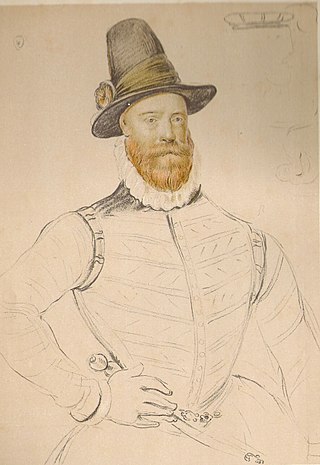
James Douglas, 4th Earl of Morton was a Scottish nobleman. He played a leading role in the murders of Queen Mary's confidant, David Rizzio, and king Henry Darnley. He was one of the last of the four regents of Scotland during the minority of James VI and I. He was in some ways the most successful of the four, since he won the civil war that had been dragging on with the supporters of the exiled Mary, Queen of Scots. However, he came to an unfortunate end, executed by means of the Maiden, a predecessor of the guillotine.
William Sinclair (1410–1480), 1st Earl of Caithness (1455–1476), last Earl (Jarl) of Orkney, 2nd Lord Sinclair and 11th Baron of Roslin was a Norwegian and Scottish nobleman and the builder of Rosslyn Chapel, in Midlothian.
Earl of March is a title that has been created several times, respectively, in the Peerage of Scotland and the Peerage of England. The title derives from the "marches" or borderlands between England and either Wales or Scotland, and it was held by several great feudal families which owned lands in those districts. Later, however, the title came to be granted as an honorary dignity, and ceased to carry any associated power in the marches.

The Earl or Mormaer of Lennox was the ruler of the region of the Lennox in western Scotland. It was first created in the 12th century for David of Scotland, Earl of Huntingdon and later held by the Stewart dynasty.
Archibald Douglas, 8th Earl of Angus and 5th Earl of Morton was a Scottish aristocrat.
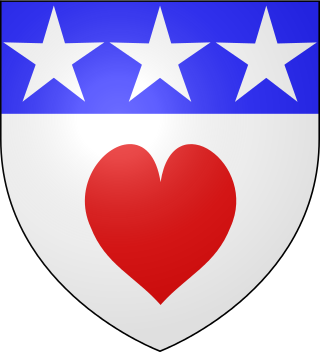
This page is concerned with the holders of the forfeit title Earl of Douglas and the preceding feudal barons of Douglas, South Lanarkshire. The title was created in the Peerage of Scotland in 1358 for William Douglas, 1st Earl of Douglas, son of Sir Archibald Douglas, Guardian of Scotland. The Earldom was forfeited by James Douglas, 9th Earl of Douglas, in 1455.
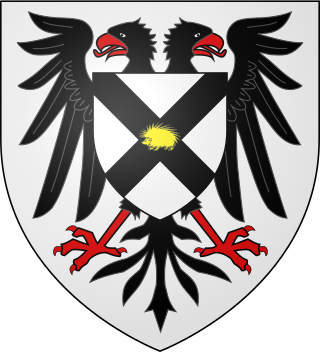
Earl of Nithsdale was a title in the Peerage of Scotland. It was created in 1620 for Robert Maxwell, 9th Lord Maxwell, with remainder to heirs male. He was made Lord Maxwell, Eskdale and Carlyle at the same time. The title of Lord Maxwell had been created in the Peerage of Scotland in 1445 for Herbert Maxwell.
William Douglas, 6th Earl of Morton was the son of Robert Douglas of Lochleven and Margaret Erskine, a former mistress of James V of Scotland.
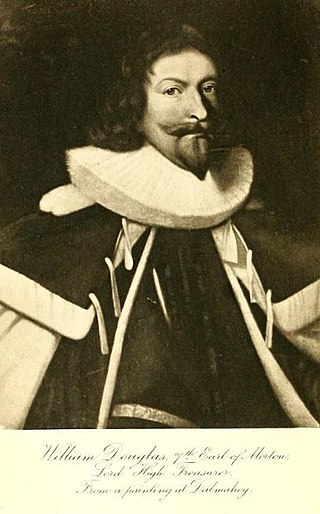
William Douglas, 7th Earl of Morton was a grandson of the 6th Earl of Morton. He was Treasurer of Scotland, and a zealous Royalist.
James Douglas, 3rd Earl of Morton was a son of John Douglas, 2nd Earl of Morton and a grandson of James Douglas, 1st Earl of Morton and Joan of Scotland, a daughter of James I of Scotland. He married Catherine Stewart, an illegitimate daughter of King James IV of Scotland by his mistress Marion Boyd. The couple had three daughters; Margaret, Beatrix, and Elizabeth. He was succeeded by his son-in-law, James Douglas, 4th Earl of Morton, husband of his daughter Elizabeth.

James Douglas, the 4th Lord of Dalkeith, was created the 1st Earl of Morton in 1458.
George Leslie, 4th Earl of Rothes was a Scottish nobleman and diplomat.

Clan Douglas is an ancient clan or noble house from the Scottish Lowlands.
Archibald of Douglas was a Scottish nobleman. He was the son of William of Douglas.
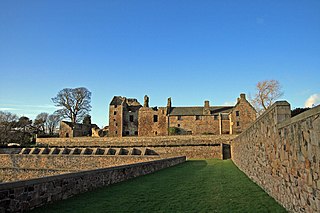
Aberdour Castle is in the village of Easter Aberdour, Fife, Scotland. Parts of the castle date from around 1200, making Aberdour one of the two oldest datable standing castles in Scotland, along with Castle Sween in Argyll, which was built at around the same time.
James Douglas, 1st Lord Dalkeith was a Scottish nobleman born in Dalkeith, Midlothian, Scotland to Sir James Douglas and Agnes Dunbar. James was the brother of Nicholas Douglas, 1st Lord of Mains.

Robert Maxwell, 1st Earl of Nithsdale, was a Scottish nobleman. He succeeded his brother as 10th Lord Maxwell in 1613, and was created Earl of Nithsdale in 1620. General of Scots in Danish-Norwegian service during the Thirty Years' War. A loyal supporter of Charles I and a prominent Catholic, he lost his titles and estates in 1645, dying on the Isle of Man in 1646.
John Maxwell, 8th Lord Maxwell was a Scottish Catholic nobleman. In 1581 he was created Earl of Morton, and in 1587 he travelled to Spain where he took part in the planning of the Spanish Armada.
The feudal barony of Dirleton was a feudal barony with its caput baroniae originally at Castle Tarbet, Elbottle Castle and later at Dirleton Castle in East Lothian, Scotland. The Lordship & Barony of Dirleton lay in East Lothian a few miles west of North Berwick, the land comprising the Caput of the Barony is today only a little over 40 acres, including the Island of Lamb, North and South Dogs in the east coast of Scotland. Its ruined castle, two triangular greens and the buildings are grouped in the traditional style of a medieval township. Dirleton Castle was built in the middle of the twelfth century by a branch of the Anglo-Norman family of De Vaux, a family with its origins in Rouen, Normandy, which had settled in Dirleton during the reign of King Malcolm IV (1153‒1165). The original castle was modelled on contemporary French castles, in particular Coucy la Chateaux north of Paris. Dirleton Castle was defended against the invading army of Edward I of England in June 1298, but eventually fell to Anthony Beck, the fighting Bishop of Durham. In 1311 the castle was recaptured by the Scots and Robert the Bruce ordered that it be reduced (ruined) to eliminate the possibility of it being occupied by the English in the future. Dirleton was in the hands of the De Vaux family for about two centuries.
William Douglas, Earl of Morton was a Scottish nobleman and Earl of Morton.










